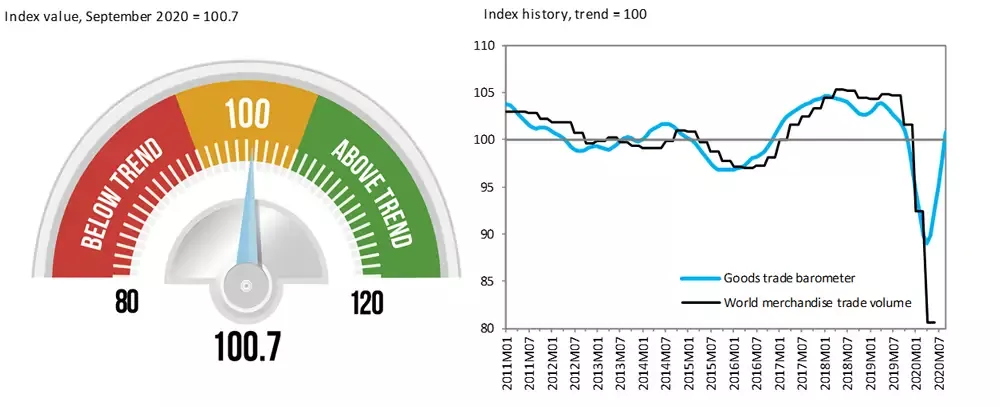
World merchandise trade appears to have rebounded strongly after plummeting in the midst of the COVID-19 pandemic, but whether growth can be sustained going forward is unclear, according to the WTO’s latest Goods Trade Barometer released on 20 November. A sharp rise in the barometer index was driven by a surge in export orders, but mixed readings in other components and the resurgence of COVID-19 could weigh on trade in the coming months.
The Goods Trade Barometer’s current reading of 100.7 marks a dramatic improvement from the 84.5 recorded last August, which reflected collapsing trade and output in the second quarter as lockdowns and travel restrictions were employed to fight the virus. The latest reading indicates a strong rebound in trade in the third quarter as lockdowns were eased, but growth is likely to slow in the fourth quarter as pent-up demand is exhausted and inventory restocking is completed.
Trade-related uncertainty remains high. A second wave of COVID-19 infection is already under way in Europe and North America, leading to renewed lockdowns that could trigger another round of business closures and financial distress. On a more positive note, progress has been reported in the development of a vaccine, but when and how it might be deployed is not yet known.
The Goods Trade Barometer is designed to gauge momentum and identify turning points in world trade growth in real time. Readings of 100 indicate expansion in line with medium-term trends; readings greater than 100 suggest above-trend growth, while those below 100 indicate below-trend growth.
All of the barometer’s component indices were rising in the latest months, with some climbing above their medium-run trends while others remained depressed. The recovery in the overall barometer index was driven by export orders (113.5) and agricultural raw materials (103.6), both of which finished firmly above trend. The indices for container shipping (102.0) and automotive products (94.6) also recovered substantially to near trend, while those for air freight (88.5) and electronic components (94.6) remained below trend.
The latest reading of the Goods Trade Barometer is consistent with the WTO’s revised trade forecast of 6 October 2020, which predicted a 9.2% decline in the volume of world merchandise trade in 2020. This outcome would require a sharp rebound in the third quarter following the 17.2% year-on-year decline registered in the second quarter.
Normally the Goods Trade Barometer anticipates turning points in world trade by a few months, but new sources of uncertainty related to the COVID-19 pandemic may have reduced the predictive value of its component indices. Under these circumstances, higher-frequency (i.e. daily or weekly) statistics may provide additional signals of economic activity and trade to complement the standard set of indicators. These indicators point to a stalled recovery of international flights and container shipping in October, but improved economic sentiment as reflected by copper futures and press reports (see below).
The full Goods Trade Barometer is available here.
Further details on the methodology are contained in the technical note here.
The trade barometers provide a preview of trends in WTO trade statistics, which can be downloaded at data.wto.org. Forthcoming releases include merchandise and commercial services trade values on 27 November and merchandise trade volumes in mid-December.


